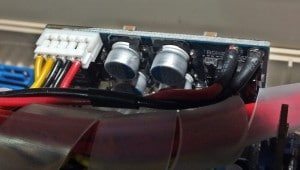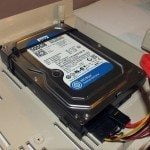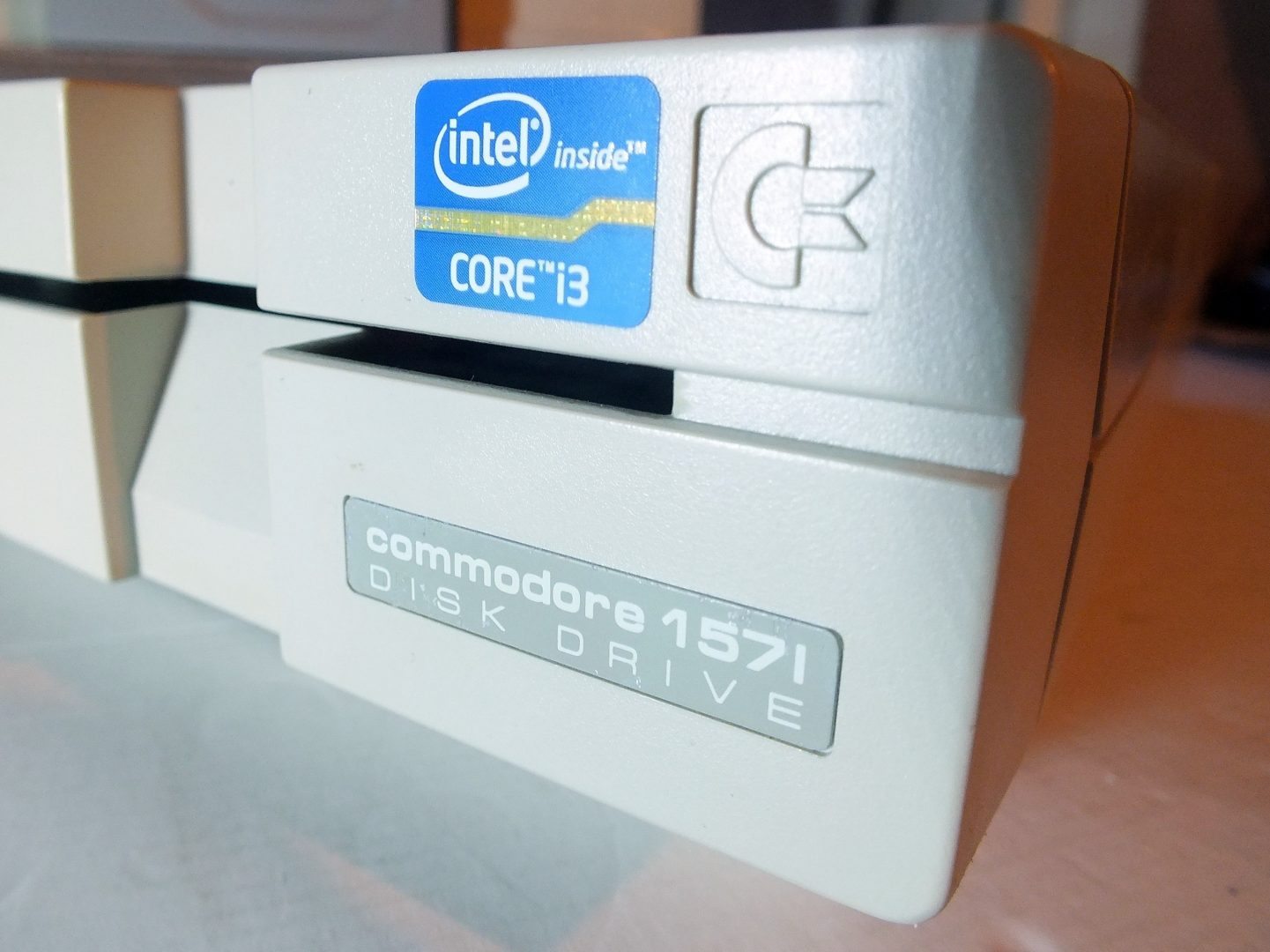Obtaining the case.

It all started while talking to a mate of mine who was searching for a Memotech MTX512, another Z80 CPU computer. I was loathing to ask Ruben for money, but knowing that I had a penchant for Commodore products, he mentioned that he had a Commodore 1570 disk drive with no use for.
I was not sure whether the MTX512 was functioning or not, while he did advise me that he thought the 1571 was faulty. It didn’t matter to me as I had a plan in mind.
We duly met outside work and just like a couple shady drug dealers, made the swap. Getting home excited that evening and examining the drive, it was evident that it was beyond repair, or at worst, expensive to fix.
Looking at the large, empty space in the drive, I realized that there was a world of possibilities to be found.
Fitting the motherboard.

Meanwhile I had found a motherboard that had approximately the same width constraints of the drive. But would the height fit? Due to the sloping bottom side design, I had to find a way of fitting the board. Conveniently, I made use of the screw pillars, dremeling in a couple of slots to slide the motherboard through, UPSIDE DOWN. To facilitate fixing from the front, I fitted two stick on cable-tie holders. These were fixed through the front fixing holes of the motherboard. Thus the motherboard could be made fixed without it moving.
The problem was at the back. There was nowhere for the I/O shield to be fitted, and initially I thought that I would fit in a Logitech mouse/keyboard wireless dongle, a wireless bluetooth adapter, and a WiFi dongle. This would evade having too many cables hanging from the back.
I had no idea what to do about power
I would be content with just a vga cable coming out of the rear, although at that point I had no idea what to do about power. I mean, an i3 draws some hefty power, and extending a dozen wires didn’t seem too appealing.

Finally I took the sad option of asking for help to ‘rout’ the back of the drive, since, as I thought it over, there was no way of fixing a drive which I would never probably use. Asking Martin, a friend for his able aid, he measured the I/O shield, and beautifully dremeled a perfect fit. Now with the shield in place and the motherboard secured, it was time to think about a power supply.
The Power Block.
Fortunately I found a 12v to 24-pin adapter on the internet which would help me simply attach a 12v laptop power supply to a switched-mode power unit. So a hole was drilled for the power socket, the power block installed and everything tied down to allow for better air-flow.
 Bench-testing this block outside of the case, I found that the power lines were steady. An oscilloscope confirmed that the smoothness was more than enough. Unhappily, there was only one hard-disk output from the block, a split SATA/IDE power unit. I needed nothing more since I would only use one drive.
Bench-testing this block outside of the case, I found that the power lines were steady. An oscilloscope confirmed that the smoothness was more than enough. Unhappily, there was only one hard-disk output from the block, a split SATA/IDE power unit. I needed nothing more since I would only use one drive.
I left the motherboard running for over two days with a hard-disk attached, and the voltages and temperature did not even waver a bit. Great!
System Storage.

Next was the storage. To accept torrents and downloads, I decided to go for a larger hard-drive. To make this build as cheap as possible, I used a Western Digital Caviar Blue 500Gb SATA-II mechanical drive. This went on the bottom of the plastic housing of the drive, with two screws being available from the air-slots , while unhappily, I had to tie down the other side of the drive with two strong cable ties to avoid slippage. A folded SATA cable completed the installation of the storage.
Temporarily I passed a small ‘push-to-make’ switch at the back, and connected the two large rectangular LEDs at the front of the unit.

So with the tightening of the screws connecting the top, bottom, front and I/O shield, the physical part of the build, to me, the most difficult part, was now complete.
Testing.
It was with a great feeling of satisfaction to connect the power supply, switch on the electricity, and push the little button at the back, watching the computer boot into the BIOS. I just sat there and stared. The urge to burst into tears was great. Honestly, it was all I could do to keep my emotions in check.
The Operating System.

Next up was a choice of an operating system. So far I had spent 35Euros on a motherboard, 110 Euros on a processor and 35 Euros on the RAM. The power block was 12 Euros and a 500GB mechanical hard-drive costs around 50. So the total had already come up to 240Euros. This is for a decently powerful set-up though, and not limited by power at all. I am sure that a different processor, such as a dual-core celeron would still do the job I had in mind.
So it was only natural that for this ‘hobbyist’ build, I was loath to purchase an operating system. 110 Euros for Windows 10 is way beyond what any OS should cost, and of course, over the years I had grown weary of the whole Microsoft ecosystem.
I have to admit that initially I was going to plump for Mint Chameleon but for some reason decided to go for Ubuntu (ah yes someone facebook mentioned to test steam on ubuntu). Many times I had tried this flavour of Linux and failing the hurdle just because I was too lazy to relearn everything, especially terminal commands which seemed so different from good old MS-DOS. However, with the purchase of a number of Raspberry PI’s, I had gone into the system enthusiastically. I know that Raspbian bears little resemblance to a full-blown Ubuntu system, but the groundwork was already there.

With Ubuntu downloaded onto a pen-drive I started the installation which went, obviously, smoothly enough, and within an hour, I was up and running, with all drivers recognised and installed. How can Ubuntu do that, and Windows still struggle with such a simple request?
After connecting to the WIFI via a small dongle (which I intend to move inside the case), I let the OS download the updates quietly. Soon, once again, it was all done.
For many years I have used LibreOffice as my main productivity suite. I found it suited my needs quite excellently. This was next to be installed, followed swiftly by GIMP, OpenShot, WINE and of course SCUMMVM… what can I say? I love the old Lucasarts games.
Stella (ATARI 2600) was next, as well as the FUSE Spectrum Emulator. After that, Chromium was installed and I logged on to my account. My Chromecast worked without a problem, and if anything, it was more stable than the Windows version. My multimedia program of choice is VLC and it doesn’t disappoint.
One of the reasons I simply had to keep Windows was the Blitz programming language. I have so many years experience programming with Blitz that I simply cannot be parted from it. However, in this latest incarnation of WINE, Blitz ran without a hitch, and it was a satisfying moment to see it running without any problems.

I also ported across MAME32 from Windows as I had a complete 300 ROM collection that I loved. Mame also ran flawlessly. I was happy to see that.
If there is anything I do not like much about Ubuntu are the colour scheme and the icon set. However, apt-getting ubuntu-tweak took care of that, and as an old Apple hand, I downloaded OS icons and themes, which made it all seem so familiar again. This gave Ubuntu a light, airy feeling that I loved working with. Naturally,the familiarity of the icons made it quicker for me to get to grips with the system.
Conclusion.
This computer is now in its’ fourth week of use, and to be honest, Ubuntu is so good that the interface disappears as you work. This is, for me, what happens with OSX, but not with Windows. Libreoffice does what I need it to do, GIMP is more than a replacement for my favourite Paint Shop Pro, while using chromium with Chromecast extension makes sure I can use the media on the hard-drive with my home entertainment system.
Many times, after finishing a build, I use the system for a couple of weeks and then take it all apart, since for me it is the creation which is the drive. To quote a Motorhead track ‘The Chase Is Better Than The Catch’.
However, I cannot bring myself to take this ‘drive’ apart. It is so compact, so quiet, so efficient, that I have decided to use it as a second machine.
This computer has proved itself to be far more powerful than necessary on such an efficient OS. I have installed a variety of games and emulators (including PS2) which have worked without a hiccup.
Building and modding computers is a passion, and with Open-Source software not only plentiful but also of a very good quality, there really is no need for companies to keep spending money on licenses that seem to get lost or outgrown very quickly. Linux installations these days are nothing short of amazing. They are quick and easy to install, with no particular technicalities required.
The built-in software repositories are a joy to use for the uninitiated, while those of us who love to work with the Terminal, the traditional system is still available.
There are many flavours of Linux. Ubuntu and Mint are two of the strongest and most supported, while one cannot but be amazed at the beautiful simplicity that is Elementary OS. Then there is Arch Linux, which is the most customizable of them all. There is no real distro as there is no “Arch” flavor of any DE. All you get is a foundation and you can build whatever distro want, on top of it. For good or for worse, unlike openSUSE or Ubuntu there is no extra patching or integration.
We are spoilt for choice as never before, and while many argue that Linux has never gained a strong foot-hold on the market, I would like to point to anyone reading this article that it is most probably hosted on a Linux system, with its’ integrity and security.
As an IT admin at work, I have installed another Ubuntu system, and I am using it from day to day on my daily endeavours, and to be honest, I see no reason why I should revert to Windows except on my main notebook, obviously for compatibility and fault finding.


